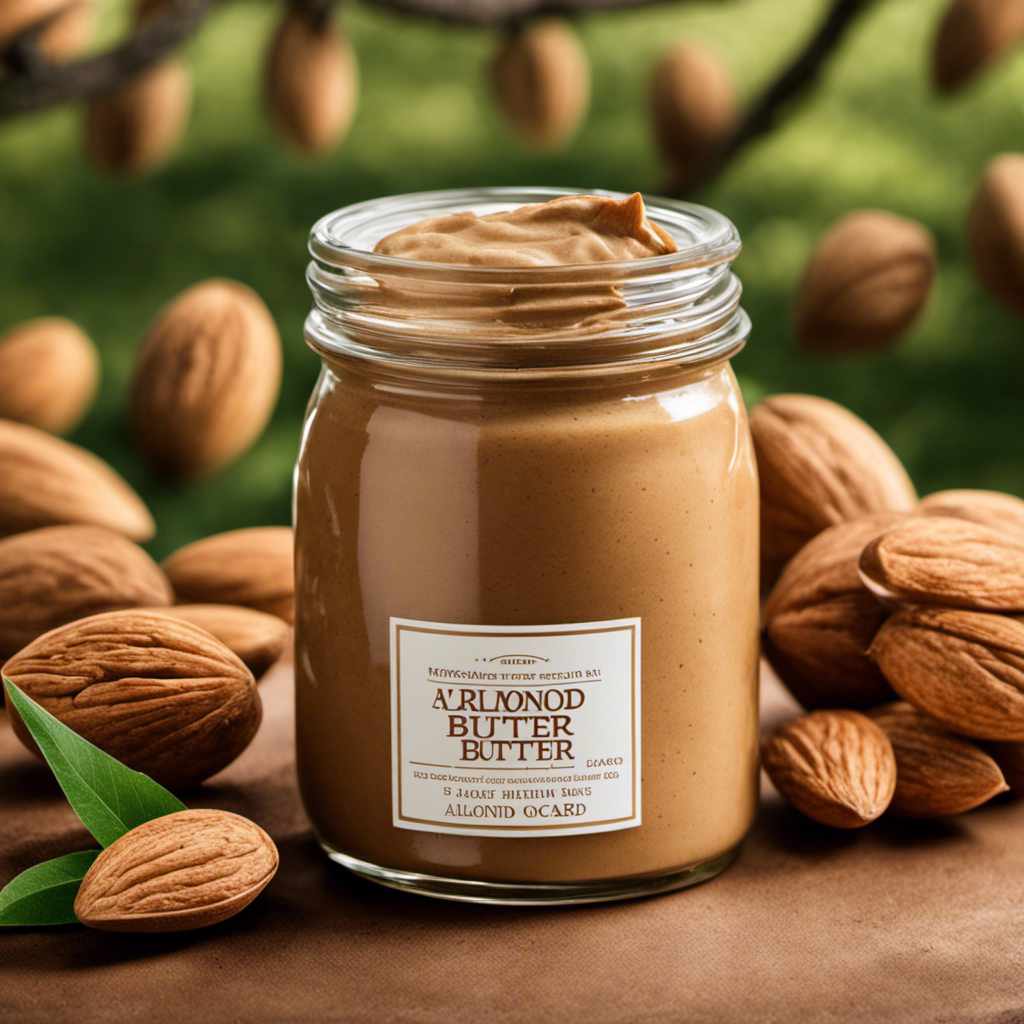As a health-conscious consumer, I frequently question why almond butter is priced higher than other nut butters. It’s natural to wonder what factors contribute to its high cost.
Surprisingly, the answer lies in a combination of factors, including the cost of almond production, growing demand, and limited supply. In this article, we’ll delve into the reasons behind the hefty price tag of almond butter and explore how these factors shape the market.
Key Takeaways
- Almond farming requires significant investments in water, fertilizers, and pesticides, driving up production costs.
- Limited supply of almonds due to challenges like drought and pests combined with growing demand for almond butter has increased prices.
- Factors such as labor, packaging, transportation, and import/export costs contribute to the overall high price of almond butter.
- Organic and specialty almond butters, which have added benefits and higher production costs, justify higher prices.
The Cost of Almond Production
The high cost of almond production is one reason why almond butter is so expensive. Almond farming involves various expenses that contribute to the overall cost.
Firstly, the cultivation and maintenance of almond trees require significant investments in water, as almonds are a water-intensive crop. Additionally, the cost of fertilizers, pesticides, and other inputs can quickly add up.
Moreover, the labor required for tasks such as pruning, harvesting, and processing further increases the expenses. Despite these high costs, almond yield and profitability can be uncertain due to factors like weather conditions, pests, and diseases. This means that farmers need to factor in potential losses, further driving up the price of almonds.
Considering the extensive costs involved in almond farming and the potential risks, it is no wonder that almond butter is priced at a premium.
Factors Affecting Almond Butter Prices
One factor affecting almond butter prices is the availability of almonds. The almond butter market trends have shown a significant increase in demand over the past few years, leading to higher prices.
Here are four reasons why almond butter prices are on the rise:
-
Limited supply: The almond industry has faced challenges such as drought and pests, which have affected almond yields and limited the supply of almonds.
-
Growing demand: Almond butter has gained popularity as a healthy alternative to traditional spreads like peanut butter. The increasing demand has put pressure on the limited supply, driving prices up.
-
Almond butter alternatives: As more consumers look for plant-based and allergen-friendly options, the demand for almond butter alternatives has also increased. This has resulted in higher prices for almond butter as a premium product.
-
Production costs: The cost of producing almonds, including labor, irrigation, and harvesting, has also contributed to the higher prices of almond butter.
The growing demand and limited supply of almonds have created a challenging market for almond butter, resulting in higher prices.
Growing Demand and Limited Supply
To understand why almond butter prices have increased, you need to consider the growing demand and limited supply. As more people become aware of the health benefits of almond butter, the demand for this delicious spread has skyrocketed. Almond butter is a great source of healthy fats, protein, and fiber, making it a popular choice for those looking for a nutritious alternative to traditional spreads. However, the production of almonds is limited and heavily influenced by factors such as weather conditions and crop yield. This limited supply combined with the growing demand has led to an increase in almond butter prices. As a result, some consumers are exploring almond butter alternatives or seeking out other sources of healthy fats.
| Almond Butter Alternatives | Almond Butter Health Benefits |
|---|---|
| Cashew Butter | Rich in Vitamin E |
| Sunflower Seed Butter | Good source of Magnesium |
| Peanut Butter | High in Monounsaturated Fats |
Processing and Labor Costs
You might be curious about how processing and labor costs contribute to the price of almond butter alternatives. Well, let me break it down for you.
-
Processing Efficiency: The process of turning almonds into butter involves various steps, such as roasting, grinding, and packaging. The more efficient these processes are, the lower the costs.
-
Labor Costs: Skilled workers are needed to operate the machinery and ensure quality control. The higher the labor costs, the more expensive the final product becomes.
-
Import/Export Costs: Almonds are not grown in every region, so they often have to be imported. This incurs additional costs, such as transportation, customs fees, and tariffs, which ultimately contribute to the overall price.
-
Packaging and Distribution Expenses: Now that the almond butter is ready, it needs to be packaged and distributed to retailers. These expenses, including packaging materials, transportation, and warehousing, further increase the price.
As we delve into the next section about packaging and distribution expenses, we’ll see how these factors add to the overall cost of almond butter.
Packaging and Distribution Expenses
Let’s explore how packaging and distribution expenses contribute to the final price of almond butter alternatives.
Packaging costs and transportation expenses play a significant role in the overall pricing of almond butter products. The packaging used for almond butter alternatives is often designed to be convenient and eye-catching, which adds to the production costs. Additionally, the use of eco-friendly and sustainable packaging materials further increases expenses.
Transportation expenses also contribute to the final price of almond butter alternatives. Almonds are often grown in specific regions, and the transportation required to bring them to processing facilities and then distribute the finished products to retailers incurs costs. The distance traveled, fuel prices, and transportation methods all affect the transportation expenses and, subsequently, the final price consumers pay for almond butter alternatives.
Organic and Specialty Almond Butters
Organic and specialty almond butters often have higher production costs due to the use of premium ingredients and specialized manufacturing processes. Here’s why they are more expensive:
-
Organic Certification: Organic almond butter requires almonds that are grown without the use of synthetic pesticides and fertilizers. Obtaining organic certification adds to the production costs.
-
Premium Ingredients: Organic and specialty almond butters often use high-quality almonds sourced from specific regions. These almonds may be more expensive than conventional ones.
-
Specialized Manufacturing Processes: Producing organic and specialty almond butters may involve additional steps, such as roasting the almonds in small batches or using stone-grinding techniques. These processes require specialized equipment and skilled labor, increasing the production costs.
-
Health Benefits: Organic almond butters are sought after for their health benefits, such as being free from genetically modified organisms (GMOs) and containing higher levels of nutrients. Consumers are willing to pay more for these added benefits.
As we delve into the impact of climate change on almond prices, it becomes evident that it further exacerbates the already high production costs of almond butter.
Impact of Climate Change on Almond Prices
In recent years, the almond industry has faced numerous challenges due to the impact of climate change. The effects of climate change, such as droughts and extreme weather events, have had a significant impact on almond prices. As a consumer, I have noticed the increase in almond butter prices, and it can be attributed to the sustainability issues faced by the almond industry.
Climate change has resulted in reduced water availability and increased water costs, which directly affects almond production. Almond trees require a substantial amount of water to thrive, and with water scarcity becoming a more prevalent issue, farmers have had to invest in more efficient irrigation systems and technologies. These additional costs are then passed on to consumers, resulting in higher almond butter prices.
To ensure the long-term sustainability of the almond industry, it is crucial for farmers to adapt to the changing climate and implement sustainable practices. This includes adopting water-efficient irrigation methods, investing in research and development for drought-resistant almond varieties, and promoting soil health and biodiversity. Only through these sustainable practices can the almond industry continue to provide us with the beloved almond butter while mitigating the effects of climate change.
Comparing Almond Butter to Other Nut Butters
Peanut butter offers a more affordable alternative to almond butter. While almond butter has gained popularity for its nutritional benefits, peanut butter remains a more budget-friendly option. Here are four reasons why peanut butter can be a great alternative to almond butter:
-
Price: Peanut butter is often significantly cheaper than almond butter, making it a more accessible option for those on a budget.
-
Nutritional Value: While almond butter may have slightly more vitamins and minerals, peanut butter still provides a good amount of protein, healthy fats, and fiber.
-
Versatility: Peanut butter can be used in a variety of dishes, from snacks to main courses, making it a versatile pantry staple.
-
Wide Availability: Peanut butter is readily available in most grocery stores, while almond butter may be harder to find or more limited in options.
Although almond butter offers unique health benefits, considering the affordability and versatility of peanut butter can be a practical choice for many individuals.
Frequently Asked Questions
How Many Almonds Are Typically Used to Make a Jar of Almond Butter?
Typically, a jar of almond butter requires a significant number of almonds to produce. The cost of almond butter can be attributed to the high demand for almonds and the labor-intensive process of making the butter.
Can Almond Butter Be Made at Home?
Yes, almond butter can be made at home by grinding almonds into a smooth paste. Homemade almond butter allows you to control the ingredients and enjoy the benefits of a fresh, preservative-free spread.
Are There Any Health Benefits Associated With Consuming Almond Butter?
I have extensively researched the nutritional value and allergenic potential of almond butter. It is indeed a healthy choice, rich in nutrients and suitable for those with nut allergies.
How Long Does Almond Butter Typically Last Before It Goes Bad?
Almond butter typically lasts for several months before going bad if stored properly. To maximize shelf life, keep it in a cool, dark place and tightly sealed. This ensures optimal freshness and minimizes the risk of spoilage.
Are There Any Alternatives to Almond Butter That Are More Affordable?
There are affordable alternatives to almond butter that offer similar nutritional value. These options can be a cost-effective choice without compromising on taste or health benefits.
Conclusion
In conclusion, it’s clear that almond butter’s hefty price tag is a result of various factors.
From the high cost of almond production to the growing demand and limited supply, there is no shortage of reasons why this nut butter is so pricey.
Additionally, processing and labor costs, packaging and distribution expenses, as well as the popularity of organic and specialty almond butters all contribute to its premium price.
And let’s not forget the impact of climate change, which further exacerbates the situation.
When compared to other nut butters, almond butter truly stands out as the expensive choice.
So, if you’re willing to pay the price for its deliciousness and health benefits, go ahead and indulge in this luxurious spread.










